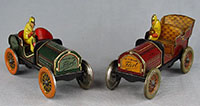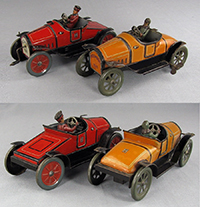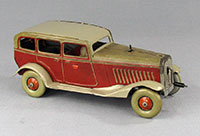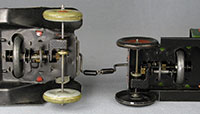 |
||||
|---|---|---|---|---|
 |
Hess Flirt Touring Car, circa 1912 L 5.25” (13.3 cm), W 2.13” (5.4 cm), H 2.88” (7.3 cm) Marked “Hess-Roller”, “Flirt”, “D.R. Pat.”, “D.R.G.M.”, “Germany”, “JLH” logo, “Marke” This Hess Flirt Touring Car was also made in a roadster version, but the touring is somewhat harder to find than the roadster. Although originally produced before 1912 in a simple flywheel version, Hess changed the propulsion to a geared flywheel / friction mechanism in 1912 and thereafter labeled the toys so equipped as “Hess Rollers” to denote the change. Although the roadster was lithographed with versions in green or black bodies, the touring car has only been observed in this one color. |
|||
 |
||||
 |
A pair of Hessmobil 1020 roadsters. Car: L 18.4 cm (without crank), W 7.6 cm, H 9.2 cm. The orange model is early, with a race type driver, spoked wheels and rounded back. The orange color is unusual as most of these were maroon red in color. The wind up mechanism rather than flywheel drive was available in other Hessmobils, but is a rare find. The bright red model 1020 is a later version with chauffeur type driver, solid wheels and flat back. |
|||
.jpg) |
Hessmobil 1020 Roadster With Rounded Back, circa early 1920s The Hessmobil 1020 roadster was made for a number of years with few variations. The early model featured a rounded trunk, deep maroon red coloring, spoked wheels and a race type driver. Later models utilized a chauffeur type driver, solid wheels and a bright red color and finally a flat back trunk. An early model has also been observed numbered simply “17”. As always with Hess, many variations exist. |
|||
 - Copy.jpg) |
||||
 |
Hess Flirt Touring Car Grouping, Circa 1900 – 1920 Car: L 5.1” (13 cm), W 2.13” (5.4 cm), H 3” (7.6 cm) with driver. All circa 1900 – 1920 Hess Flirt touring cars, all with different methods of propulsion. At left is the earliest, simply named “Flirt” , marked with the early Hess shield logo as well as the JLH logo. Some models were also marked “1063” on the rear of the vehicle. It derives propulsion from a simple flywheel drive which rests on the rear axle. At right , the clockwork version is the least seen model. This model is completely unmarked with wheels being painted one color, either gray or orange without detailed litho printing on wheels or upholstery, probably made during the war years (WW1) or slightly after. The middle car was manufactured post 1912 as it has the “Hess Roller” phrase marked on the radiator. This method of propulsion was the new “flywheel friction” mechanism. |
|||
  |
The Hessmobil lives on (partially) after Hess bankruptcy It is apparent that Tipp and Co. acquired parts, tooling, patents, etc., from the Hess bankruptcy of 1934. Tipp made the “Tippmobil Tractor”, “Tippmobil Motor” (shown in the 1937 Tipp catalog) and an unnamed and unmarked vehicle with Hess’s flywheel motor, but with Tipp’s body and styling as shown below. I suspect if this had been a success we would have seen it named the “Tippmobil”. Tippco sedan utilizing Hess’s flywheel motor. Tipp produced many military type tin toys during the mid to late 1930s. This sedan has a printed tinplate uniformed soldier behind the wheel. Tippco sedan motor on left, Hessmobil motor on right. The Tippco sedan was somewhat larger than the Hessmobil, weighing in at not quite 11 ounces (319 grams) versus 8 ounces (227grams) for the Hess product. Tipp obviously tried to compensate for this with a larger flywheel, diameter 1.6875” (4.3 cm), compared to the Hessmobil’s 1.5” (3.8 cm) flywheel. No other Tipp products with flywheel motor have been observed other than this sedan, the Tippmobil Tractor and the Tippmobil Motor. Catalog evidence can only be found for the Tractor and Motor.
|
|||

